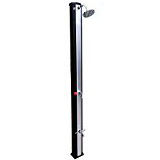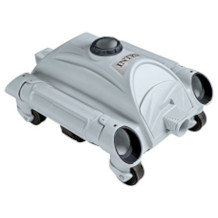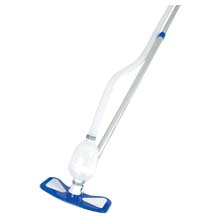Garden pool purchasing advice: how to choose the right product
- The most important facts in brief
- Garden pools are available as an above-ground version for the summer or as a built-in version for the whole year.
- If the pool is to be suitable for swimming, it must be at least 1.35 metres deep.
- Garden pools cost up to several thousand euros, depending on the material, size, type and shape.
- The surface on which the pool stands should definitely be straight and level.
Garden pools – refreshment for the home
Water has been very popular in sports and leisure activities since ancient times. However, since hardly anyone in ancient Rome knew how to swim, people bathed instead. Today, not only does almost everyone know how to swim, but swimming pools are also available all year round. Those who prefer to bathe in their own garden can resort to an alternative for private use: the pool.
The term garden pool can be defined in two different ways. It is often also referred to as an above-ground pool or prefabricated pool and means a large pool filled with water that is not embedded in the ground and is used for bathing. This definition therefore excludes in-ground pools. However, the term can also be used as a synonym for a swimming pool. In this case, both in-ground and in-ground pools are included.
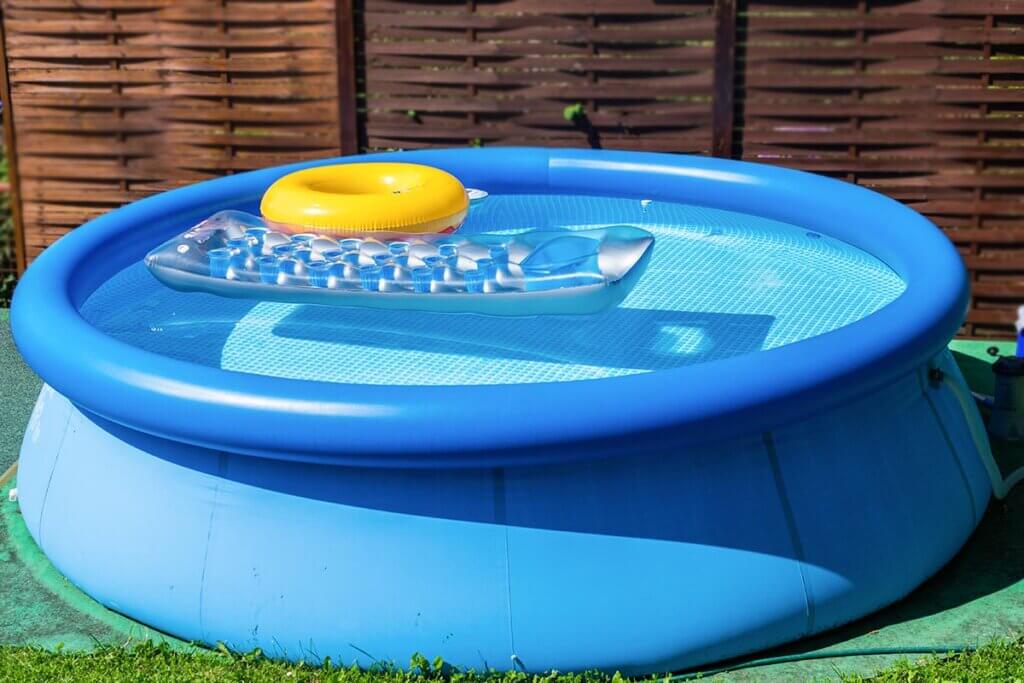
A cool paradise – the advantages of a garden pool
In summer, it gets too hot for many people and they want to cool off. But the nearest lake or beach is far away, the local swimming pools overcrowded. For garden owners, there is an equally refreshing alternative that offers several advantages to boot. With a swimming pool, no one has to queue for a long time at the pool ticket office and pay an entrance fee to swim. Instead, anyone who owns a swimming pool can go for a swim whenever they want. It is also a much more hygienic form of cooling off, as the pool does not have to be shared with anyone; care and maintenance are left to the owner himself. He or she can therefore remove or prevent contamination immediately. Last but not least, due to the smaller number of people using the swimming pool, there is less contamination of the water.
Not only children have fun in the water, adults also like to cool off. A garden pool is therefore a good investment for the whole family. In the meantime, a pool in the garden is no longer a luxury but, depending on the model, very affordable. Since there are numerous options in terms of size, shape and material, everyone can choose their garden pool individually. For children, a pool is a good opportunity to learn how to swim. Parents can keep an eye on them much better than in a full swimming pool. For adults, a swimming pool is an ideal way to relax after a hard day’s work.
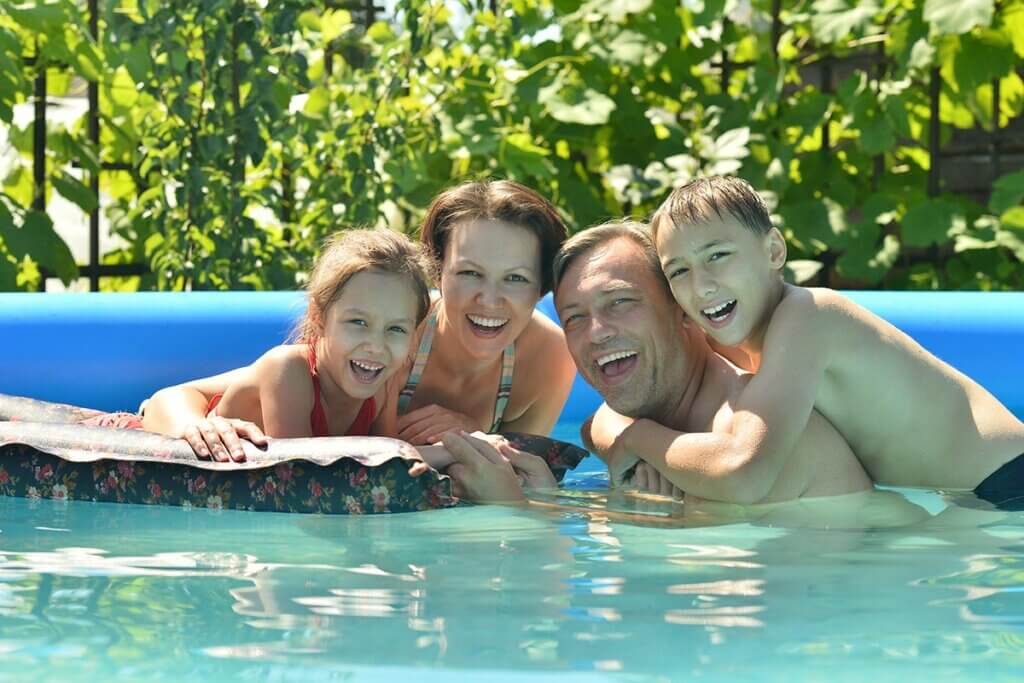
Inground pool versus inground pool
An inground pool is inexpensive and affordable for everyone. The construction of such a pool is simple and quick. Since an inground pool is flexible, it can be moved to another location at any time if necessary. In winter, the pool can be easily dismantled and stored away. In contrast to built-in pools, above-ground pools are usually smaller and therefore take up little space. However, due to their delicate materials, they do not last as long; accordingly, many have to be stored during the winter.
Unlike an above-ground pool, a comparatively higher-priced in-ground pool is embedded in the ground. This makes it less flexible. However, anyone who has the opportunity to purchase such a pool will benefit immensely. It offers enough space for sporting activities such as water polo, water gymnastics, diving or swimming. Swimming is good for the body because it strengthens the muscles, is easy on the joints and has a positive effect on the cardiovascular system. Since an in-ground pool is made of solid materials, it is much more resistant and thus less susceptible to damage than an above-ground pool. Having a swimming pool in the garden automatically increases the value of the property. This type of pool is also easier to clean.
The different models
If you want to buy a garden pool, you first need to know which model is best suited to your personal requirements.
Paddling pool

The cheapest and smallest version of the garden pool is the paddling pool. It is made of hard or soft plastic. A model made of soft plastic can only be inflated and is therefore light and easy to store. Meanwhile, a paddling pool is available in all kinds of colours and shapes. It is especially suitable for smaller children. This type of pool is very shallow and can only be filled with a small amount of water.
Quick-Up-Pool

If you want a little more water, go for the Quick-Up Pool. This is a pool made of plastic whose upper edge is an inflatable rubber ring. As soon as water is filled into the pool, it straightens up by itself. A Quick-Up Pool is a typical seasonal product, as it can be set up and taken down quickly, but is not suitable for the winter due to its unstable material.
Steel frame pool

This garden pool is also called a frame pool, as it consists of a steel frame with a plastic foil stretched over it. It is usually larger and somewhat more stable than a quick-up pool; the water does not leak out quite as quickly. It can be set up quickly and the pool can also be purchased in larger versions for swimming. However, since the steel frame rusts very quickly and the side walls are quite unstable, it usually does not last very long. It is therefore not suitable as a permanent swimming pool.
Steel-walled pool

A steel-walled pool is a somewhat more stable above-ground pool that can withstand considerably more than the previously mentioned variants. The wall of the pool is made of steel, is lined on the inside with PVC foil and is sealed at the top with a plastic rail. This type of pool is well suited both as an above-ground and as an in-ground version. Although such a pool is durable, it is not as quick to set up and dismantle.
Wooden pool

Pools made of solid wood look good and are very stable. They consist of wooden beams up to 45 millimetres thick and are also lined with plastic sheeting on the inside. They are usually very easy to assemble or available as practical complete sets. This type of pool can function both as an above-ground and as an in-ground variant. Due to the stable material of the pool, a wooden pool is much more durable than other models.
Stainless steel pool

One of the more expensive variants is the stainless steel pool. It is made entirely of stainless steel and is both elegant and durable. Because of its material, the water in the pool is heated much faster than in other pools. As steel is also very smooth, dirt and algae only stick to it. This pool is therefore easy to clean. However, it is only available as a built-in variant.
Plastic pool

Another weather-resistant version is the plastic pool. It is made of glass-fibre reinforced plastic (GRP) and is usually supplied as a prefabricated pool. Particularly high-quality models are made of a plastic that is reinforced with carbon fibres as well as Kevlar and is thus particularly strong. Such a pool is only available as an installation version and lasts a very long time.
Polystyrene pool

In a pool made of compacted polystyrene, the walls are composed of polystyrene building blocks that are connected to each other by a plug-in system. The bottom of the pool is made of non-slip polystyrene panels. Inside, the pool is lined with foil for better sealing. It is relatively easy to assemble, weather-resistant and cheaper than other built-in pools.
Concrete pool

The heaviest and most expensive type of garden pool is a concrete pool. The biggest advantage of a solid concrete pool is its durability. It can only be built by experts and has a construction time of six to eight months. Inside, the pool is lined with foil to make the material last longer. The pool is not easily replaceable and is only possible as a built-in model.
What to look for when buying a garden pool
To make sure you invest in the right pool, there are a few aspects you should pay attention to. The size, shape, price and accessories are particularly important.
Size and volume
First of all, you need to consider when and for what you will use the pool most and decide on a size accordingly. For families with small children, a paddling pool is recommended because it is shallow and holds only a little water. Children can splash around in it in peace without parents having to worry about them. A paddling pool is also a good solution for families with a very small garden, as it is the smallest form of garden pool and therefore takes up the least space. As it is not particularly deep, it is also good for just putting your feet in on a hot day. If you want a slightly larger pool, a quick-up pool is a good choice. It is usually no higher than 80 centimetres and has a diameter of between 2.7 and 3.5 metres. It is particularly suitable if you don’t want to waste a lot of time setting it up and only want a small pool to cool off in.
If you prefer your pool for swimming, you should go for a larger version. In this case, it should have a length of at least 6.00 metres. The height should then be at least 1.35 metres so that it can reach a water level of 1.20 metres. Neither paddling pools nor quick-up or steel frame pools are usually available in this size. If you want a pool like this, you have to go for a polystyrene, wooden, stainless steel, plastic or concrete pool. If two people are to be able to swim in the pool at the same time, the pool must be at least 4.00 metres wide so that the swimmers do not get in each other’s way. When choosing a pool, always consider the size of your garden. A pool that is too large in a small garden looks out of place.
Material
The material of the pool is particularly important if it is to last a long time and not just be a seasonal product. Quick-up pools as well as paddling pools are made of thin plastic and are therefore susceptible to damage from animal claws, sharp stones or storms. So if you have pets and want to enjoy your pool for a long time, you should rather go for a version made of sturdy material. Steel-frame pools are somewhat more stable than the pool types already mentioned, but they rust quickly and are also made of thin plastic on the sides. Pools that can withstand different weather conditions and are intended to last for several years should be made of polystyrene, wood, stainless steel or glass-fibre reinforced plastic. For wooden pools, the types of wood Nordic pine and Nordic spruce have proven to be particularly durable and long-lasting.
Price
The price varies depending on the type and size of the pool. So consider what your budget is for the pool. If you want a particularly inexpensive and quickly assembled version, a paddling pool is ideal. It only costs between 10 and 50 euros and is available in a wide variety of colours and shapes. A quick-up pool is larger and therefore more expensive, but still cheaper than all other types of garden pool. It costs between 50 and 200 euros. Steel frame pools range in price from 80 to 250 euros, steel wall pools and plastic pools start at around 300 euros.
The larger, more elaborate inground pools are considerably more expensive. A wooden pool is available from 1,500 euros, a polystyrene pool from 3,000 euros and for stainless steel and concrete pools you have to reckon with a five-figure sum. In the case of inground pools, there are also the costs of digging the pit and installing the pool. With any pool, even a paddling pool, there are also costs for the water to be filled in. Drinking water costs around four euros per cubic metre, depending on the consumer and including sometimes high wastewater costs.

How do I calculate the water requirement for my pool?
The water volume of the pool is quickly calculated. If the pool is rectangular, simply multiply the length by the width and the depth. The result is the volume of the pool in cubic metres. If the pool is round, you have to determine the volume of the cylinder, which is a little more complicated. The volume is obtained by multiplying the base area by the height. You calculate the base area by multiplying the radius squared by the circle number Pi (around 3.14). Exactly 1,000 litres fit into one cubic metre. So if the pool has a volume of 24 cubic metres, it needs 2,400 litres of water. Since one cubic metre of water costs about four euros, this would be a cost of about 96 euros.
Shape
Since garden pools come in a wide variety of shapes, you should consider which one fits best in your garden. Not only does the look play a role, but also the type of pool. Quick-up pools, for example, are always round or oval, while paddling pools are usually either round or square. Most other pools come in round, oval, rectangular, octagonal or octagonal shapes. Steel wall pools as pop-up pools are only available in round, oval or octagonal shapes, as the water pressure would force the pool out of its shape if it were rectangular. Wooden pools need a concrete foundation if they are rectangular in shape, otherwise their stability suffers. The construction of such a pool is therefore more complex. Also bear in mind: round pools require more space to set up than rectangular ones.
Accessories
There are a number of pool accessories that can make your pool cleaner and safer.
Filter system
A filter system is important for the cleanliness of the pool. Without one, the water would “tip over” after a few days. Then the water becomes discoloured and smells very unpleasant. Sand filter systems are the most popular type of pool cleaning. Water is filtered through a layer of quartz sand and then pumped back into the pool. Sand filter systems screen out coarse and fine dirt very effectively, but are also somewhat more expensive to purchase. Cartridge filters filter the water through a paper cartridge to which dirt gets stuck. They are less powerful, but also cheaper. The least popular type of filter system is the so-called precoat filter. They filter with the help of diatomaceous earth, i.e. shells of fossil diatoms, and are not particularly effective. If you have a small pool, it is best to use cartridge filters. Sand filters, on the other hand, are more suitable for large pools. Note that a filter that is too small will not clean the water sufficiently: the larger your pool, the larger the filter system.
Pump
A filter system also includes a pump: it draws in the water and directs it through the filter system. It can also distribute pool cleaning chemicals evenly throughout the water. Make sure that the pump is adapted to the size of the water. A pool set usually includes a complete filter system including pump, which is why it is well suited for inexperienced buyers. If there is no pump integrated in the filter and you have to get an additional one, you should make sure that its power matches the water volume of the pool. The power, which is given in kilowatts, should correspond to one third of the water volume in litres.
Ladder
To make it easy to get into the pool, it should be equipped with a ladder or stairs. For above-ground pools, a simple ladder is usually included in the scope of delivery; for in-ground pools, a staircase is often installed. Make sure that the steps are stable. A ladder should be made of rustproof material and ideally have rubber anti-slip protection on the steps. Stability is also important and should be checked thoroughly. Only if the ladder’s legs extend sufficiently will it not tip over. A railing provides additional support, which is especially important for older people and children.
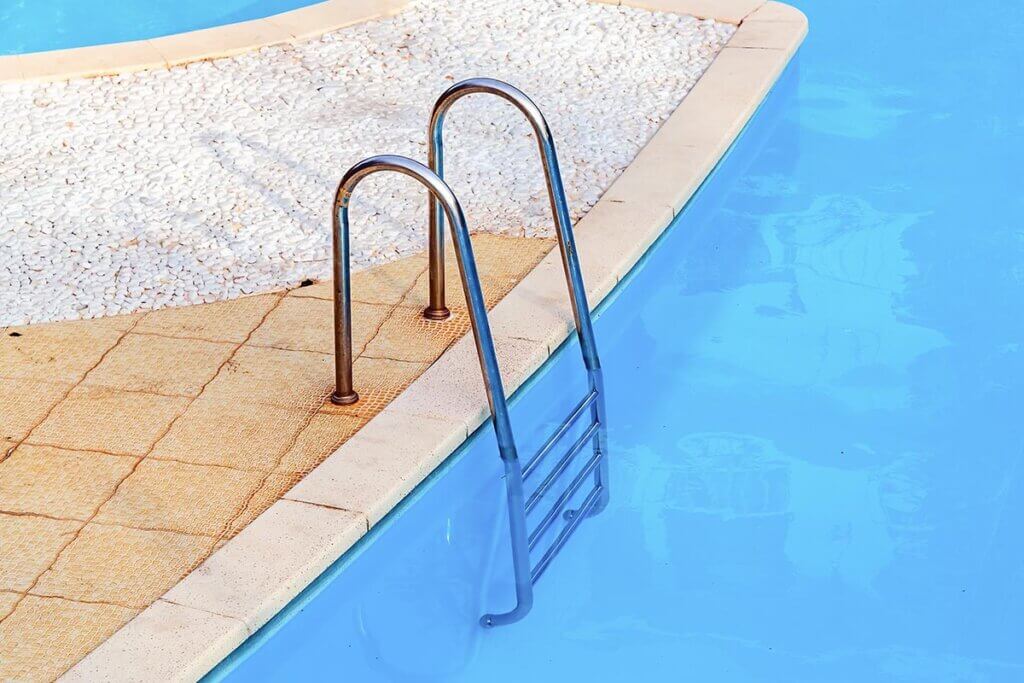
Cover
Another important extra is the pool cover. It serves to protect the pool because it keeps dirt away from the outside. This makes it easier to clean the pool and the filters are less strained. If the pool stands outside for a longer period of time or , a high-quality cover is worthwhile. It also prevents the water from evaporating or cooling down. There are now even solar covers that heat the pool with sunlight and keep it warm. Those who have a pool heater also benefit from such a cover, because it keeps the heat in the pool, which warms it up faster and saves electricity. It also prevents people or animals from falling into the pool.
Heating
For pool use in winter, a pool heater is a necessary feature. It provides cosy warm water in colder temperatures. Even in autumn or spring, the weather is usually not warm enough for swimming – a pool heater changes that. High-quality heat pumps have an LCD display that can be used to set the temperature precisely. For smaller pools, a solar pool heater that heats the water using solar energy is usually sufficient. For paddling pools, you can buy a solar mat that you place on the water.
Shower
An outdoor shower is particularly useful for regular pool use. Bathers can shower off at any time without having to walk around the house wet. The shower should ideally be made of stainless steel, brass or aluminium so that it can withstand the weather for a long time. There are also mobile versions that are equipped with a rotating leg or ground spike. This allows them to be easily fixed in the ground and stowed away when needed.
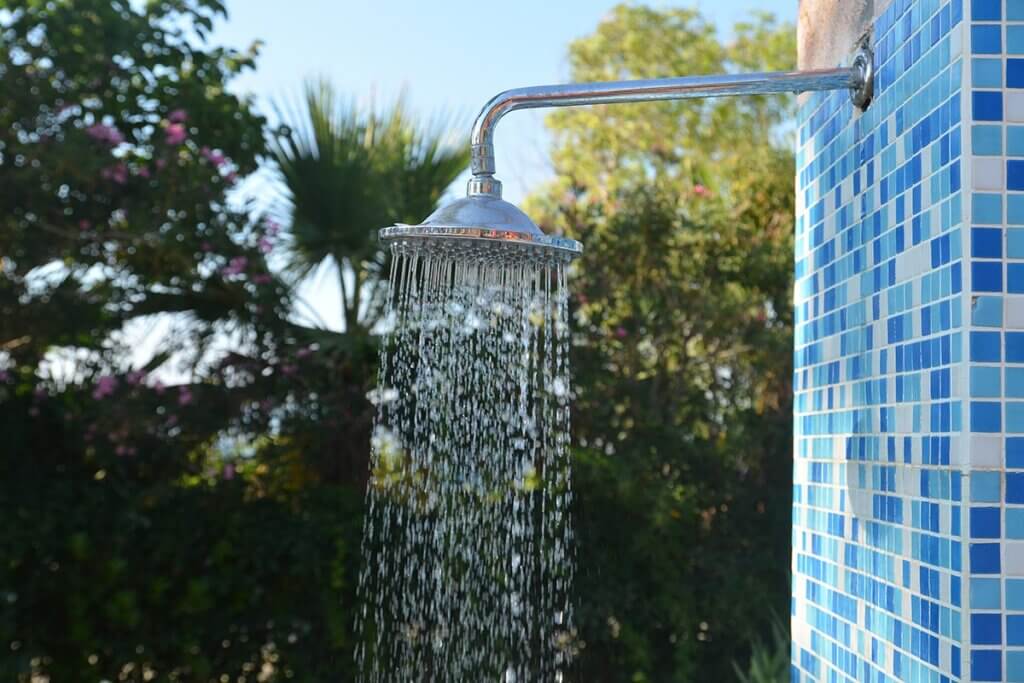
Substrate condition
The ground on which you place the pool should be checked thoroughly beforehand. Stones, roots and unevenness can cause the pool to crack in paddling pools, quick-up pools and steel frame pools. Mud and sand are also unusable as a pool substrate, as they can give way. Solid surfaces such as concrete, stone or grass are more suitable. The ground should be level, otherwise the pool, and with it the water, will become tilted. In the worst case, the pool will tip over if it is too full. It is best to mark the surface on which the pool is to stand. Use a spirit level to check whether the ground is really completely level before you place the pool. If this is not the case, you can remove soil to level out any unevenness. For an in-ground pool, an uneven floor is also unfavourable, as the water is then unevenly distributed and may run out.
Care and maintenance tips
You need to clean your pool regularly so that the fun of swimming does not become a dirty affair. This involves both changing the water and cleaning the pool itself. Depending on what type of pool it is, the amount of work varies a little.
How often do I have to change the water in the pool?
How often you need to clean the pool depends on both the use and the type of accessories. If your pool has neither a filter system nor a cover and is in use for long periods of time every day, you should change the water every two to three weeks and clean the pool thoroughly afterwards. If your pool has both accessories, one cleaning per bathing season is sufficient, i.e. once a year. It is recommended that you change the water with thorough pool cleaning in the spring before you start using your pool again.
The pool filling
Drinking water is best for garden pools as it is the easiest to keep clean. Depending on the size of the pool, filling takes different amounts of time. For a 3.6 metre pool, you should allow about six hours, for larger pools sometimes several days. For these garden pools, it is worthwhile to borrow a standpipe with a water meter from your local water company and use a hydrant to tap water. This is quicker and much cheaper than using a garden hose. Some waterworks offer favourable water rates for allotment gardeners.
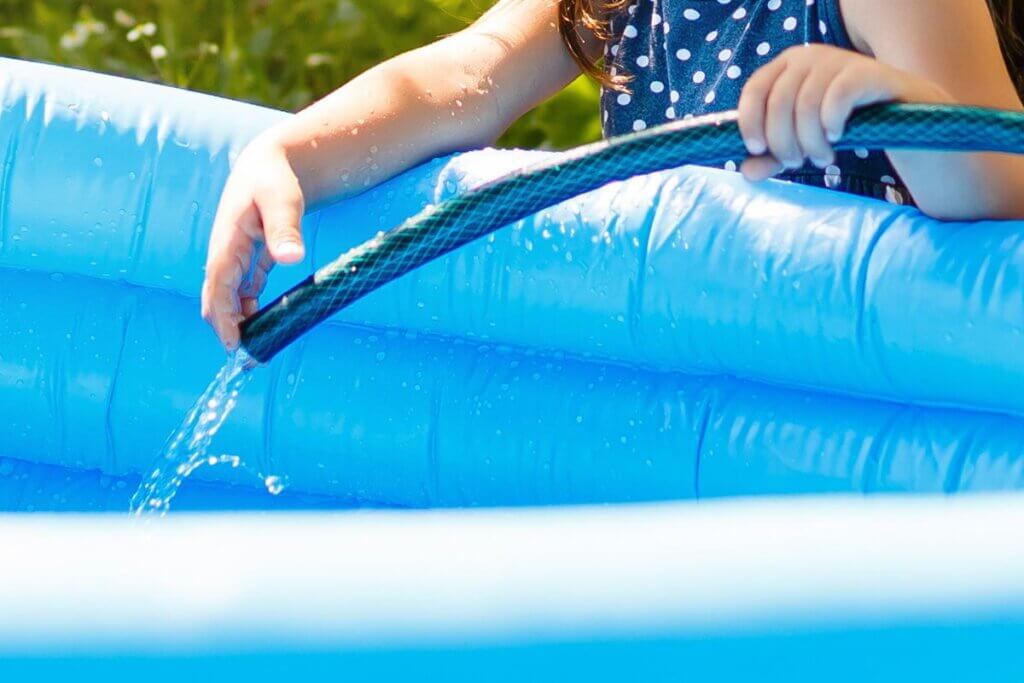
Change once, please!
If you need to drain the water for winter storage or cleaning, there are different options. For small pools and a large enough garden, you can empty out the water in your garden and let it seep into the ground. In smaller gardens, it is advisable not to dump the water out all at once, but rather a small amount over several days. Also, the water should be free of chemicals. You can also use the pool water to water flower beds. In this case, the chlorine content must be below 0.05 milligrams per litre and there must be no algaecide in the water. Larger amounts of water should be disposed of in the toilet or bathtub using a hose and pump. In some federal states, it is forbidden to discharge water into the sewer; in others, you need a special permit. To be on the safe side, check with the water company in your region.
How to clean your pool
First, remove all superficial dirt from the pool with a landing net. Then drain the pool water so that you can clean the pool tray. You should clean it thoroughly with a special cleaning agent for pools. Dirt can be easily removed with a floor brush, hand brush or suction brush. For larger pools, it is advisable to purchase a pool robot. This is an automatic cleaning device that works with rechargeable batteries and cleans the bottom of the pool quickly and effectively. However, as it is expensive, it is only worthwhile for large and frequently used pools. For smaller pools, you should rather use a pool hoover, which works similarly to a hoover.
When you have finished cleaning the pool, rinse it thoroughly with clear water to remove any residual dirt and cleaning agents. You should then check the filter layer and replace the cartridge or sand. Finally, fill the pool with water again and add chlorine for disinfection. It is best to check the water quality regularly. If algae form more frequently in your pool, add algaecide.
For paddling pools, quick-up pools and steel frame pools, be sure to check the walls and bottom regularly for cracks. Even a small crack can cause water to escape; if the water is chlorinated, this will harm the plants in your garden. As these pools are not weatherproof, you should drain the water in winter and thoroughly clean the pool of algae and dirt. It is best to hose down the entire surface with clean water. The pool must be completely dry before you store it, otherwise it will become mouldy. Ideally, you should store the folded pool in the cellar or tool shed.
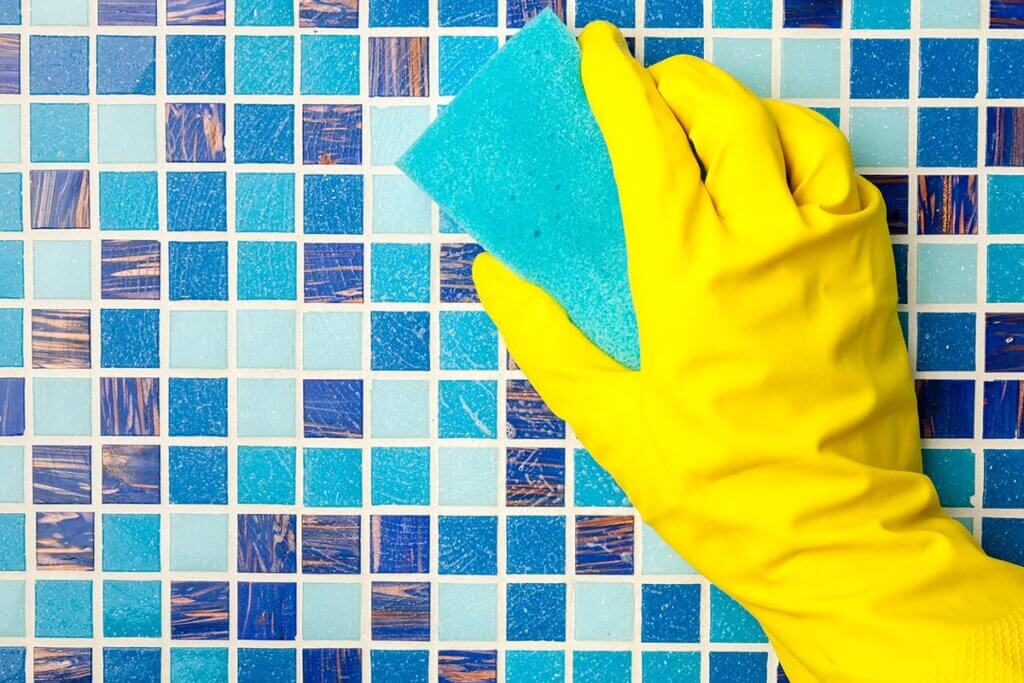
Where is the best place to put the pool?
The pool should be placed in a suitable location. Ideally, it should not be in the shade, as the water does not heat up quickly and does not stay warm as long as it does in the sun. You should also avoid placing the pool in particularly windy places, as the wind could quickly cool down the bathers. Under trees, the pool often gets fallen leaves or blossoms. Since this means more cleaning effort, the pool should not be placed there either.
Does a pool need planning permission?
Smaller pools do not need planning permission. For larger pools, regulations vary from state to state. In some federal states, all prefabricated pools with a water volume of 50 cubic metres or more require a building permit, in others the limit is 100 cubic metres. The best thing to do is to ask the relevant building authority. The building application is usually free of charge.

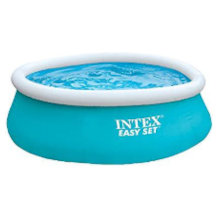
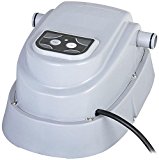
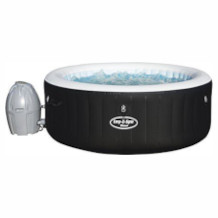



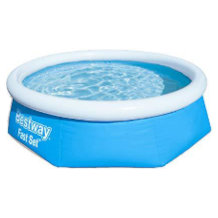


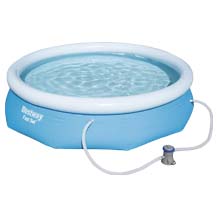
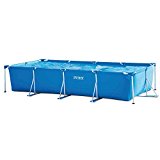
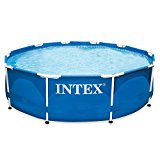
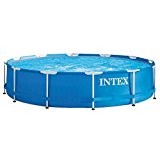
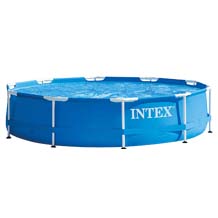
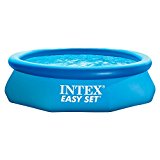

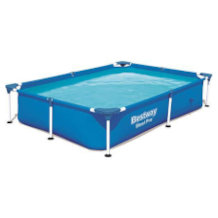

 32,048 reviews
32,048 reviews


